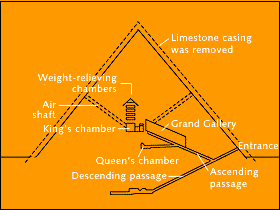
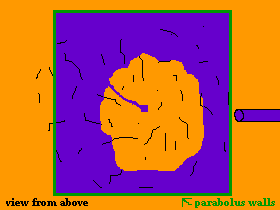
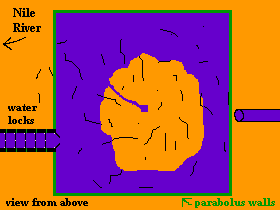
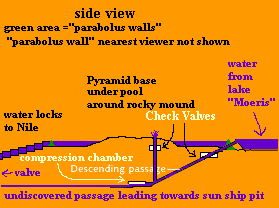
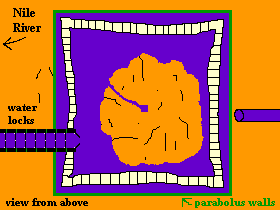
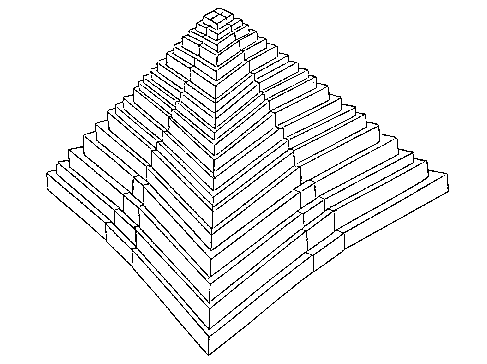
Below are some excerpts from the book Pharaoh's Pump.
The handling of such huge precision-cut masterpieces, demands absolute control of the handling medium. - This fact is a superlative, MUST. If a rectangular trench were cut inside the casing stone base, so as to form a moat, the base would then resemble, a tow-path alongside a canal. A barge with brackets on the side to carry the block could be floated to location in the moat; then lowered into place by draining the moat. Thus; a 16 ton block could be moved and set; as gently as mother lays a sleeping babe in a crib.
After the ditch was filled, the builders could move stone laden barges
freely about in the pool, and go about their Pyramid building in a big
way.
The completion of the first course of casing stones formed a rectangular
enclosure, in which water could be impounded, and the bottom of the
moat became a foundation for the back-up blocks.
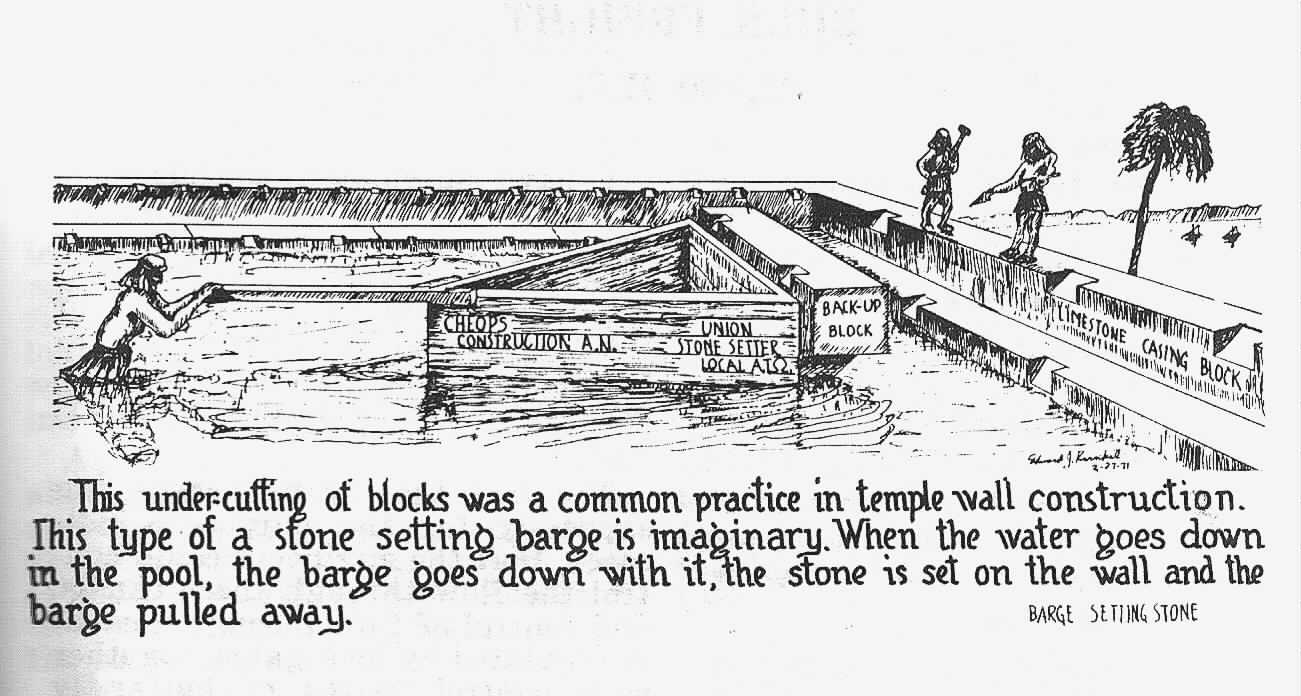
Herodotus said: "… they raised the remaining stones to their places
by means of machines formed of short wooden planks. The first machine
raised them from the ground to the top of the first step, on this there
was another machine, which received the stone on its arrival, and conveyed
it to the second step, whence a third machine advanced it still higher."
Another translator of Herodotus offers this translation.
"They made it first in the shape of stairs, and lifted up the stones
that remained with engines made of short timbers. From the ground
they raised them to the first range of stairs; when the stone came up ot
this, it was set in another engine that stood on the first range, and drawn
up from this to the second range; and thence by another engine to the third,
for there were as many engines as there were ranges of stairs… or per-adventure
there was only one engine . . ."
Here is a variation of the two translations. In the first, the
word, "machine" is used, while in the second, the word, "engine."
But the gist of the translations are identical.
In modern usage, the words, 'engine' and 'machine' are often used synonymously.
- And it may be here, that in the translation of the ancient Greek, the
meaning of these two words, are even more closely allied.
For example; The dictionary defines the word, catapult as, "an ancient
engine of war."
By a physicist's definition, a catapult is not an engine of war, but
a machine of war. An engine uses fuel directly to make it go.
More than 100 years ago, Ohio built an elaborate system of canals.
Even today, in the vicinity of Akron, century old water-locks are in operation.
Nowadays, pleasure craft pass through them. The lock-gates are made
of wooden planks about eight feet long, - These locks are truly machines,
- They are water elevators. - A floating body can be raised or lowered
in them. - They are made of stone, and SHORT WOODEN PLANKS. - I believe
that the machines Herodotus described was a series of water-locks.
Elsewhere in the same volume, he tells of seeing an old dry-dock, which
was used by King Necos to repair damaged war vessels. Here is the joker.
How can anyone build a dry-dock and not use a water-lock? Nix, say I.
Comparatively recent excavations have exposed the cutting of a giant
rock-hewn stairway with huge risers, ascending from the basin to the top
of the knoll. This cutting has the basic characteristics of the remains
of a series of water-locks, although every vestige that would indicate
water-locks, is gone.
As they are today, these stairs are too wide to be of practical use
as water-locks, but if a wall were built in the center of the steps, thus
dividing the stairway in two, the result would be two narrower sets of
stairs.
If appropriate masonry were placed in this divided stairway together
with pairs of water-gates made of wooden planks, and water pumped into
the locks; they would be in business ready to take stone laden barges up
one set of locks, while the empties came down through the other. - I believe
that this stairway is part of the 60 foot roadway described by Herodotus.
I do not know the exact dimensions of this gigantic stairway hewn in
the living rock. I know nothing of the size of the treads, nor the
height of the risers.
I saw a picture of this stairway. It was taken from a plane.
As I recall, there were four treads and three risers.
A friend of mine, John Woodward, who toured Egypt five years ago, said;
that, "the accepted explanation for this cutting was to extract blocks
for structural use in the pyramids."
Must I add, that I never believed this explanation for a moment, because
the cutting is too precise, to neat, and too regular.
If the ancients were quarrying blocks alone, the sides, the treads,
and the risers would have been left rough, and uneven. - then too, nearby
there is to this day, piles of broken rock which could have come from the
cutting of this stairway. - Besides, a lock system is necessary to raise
loaded barges from the plane to the base of the Pyramid.
These step-like cuttings have been filled in to make an asphalt roadway.
The roadway is approximately 60 feet wide. - We stepped it off. An
accurate measurement was impossible due to heavy traffic. I believe
it is part of the 60 foot roadway referred to by Herodotus. It enters
the basin from the northwest corner. The catch basin has been filled
in to make a parking lot.
The catch basin as Herodotus observed is about 100 feet above the flood
plain. It is rectangular. Its walls are very steep, made of
stone laid up dry, and vine covered. - The walls are not parabolous as
shown in Perring's map, dated 1839. Perhaps these stone walls are modern,
a sort of a tidying up job.